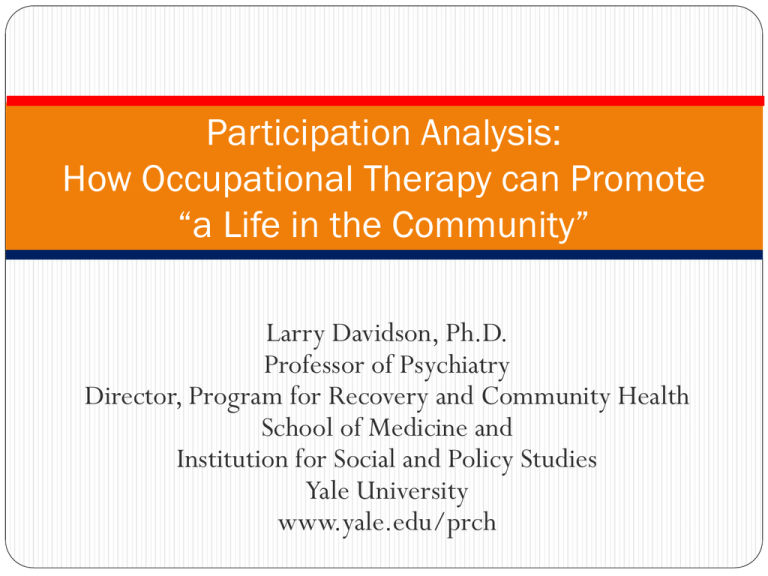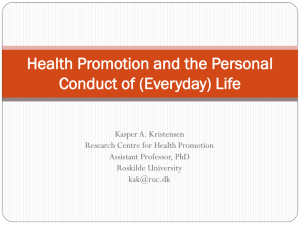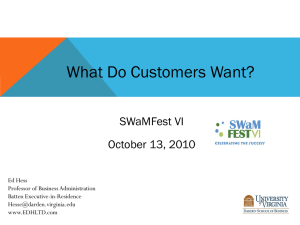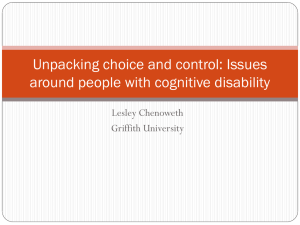Participation Analysis: How Occupational Therapy can Promote “a
advertisement

Participation Analysis: How Occupational Therapy can Promote “a Life in the Community” Larry Davidson, Ph.D. Professor of Psychiatry Director, Program for Recovery and Community Health School of Medicine and Institution for Social and Policy Studies Yale University www.yale.edu/prch Main Points Occupational therapy, since its founding as a discipline, has been very closely aligned to what is now being referred to as “recovery-oriented practice” in behavioral health There are a few ways in which occupational science and therapy could be expanded and enriched to provide a comprehensive conceptual framework for psychiatric rehabilitation These include incorporating experiential, social, and contextual dimensions into ‘activity analysis’ and utilizing this expanded form of activity analysis (which we call ‘participation analysis’) as a key tool within a collaborative relationship between the practitioner and the person in recovery Another Take on the Issue What psychiatric rehabilitation can learn from occupational therapy Reciprocal Enrichment What occupational therapy can learn from psychiatric rehabilitation A Final Take on the Issue How can we, what can we do to, promote the “life in the community” envisioned by the President’s 2003 New Freedom Commission on Mental Health? Significance of “New Freedom” designation—part of disability rights movement that led to passage of ADA in 1990 by the first Bush “New Freedom” refers to ways to enhance the autonomy of persons with disabilities—how to do this for persons with serious mental illnesses? Roots of Occupational Therapy Lev Vygotsky (1896-1934) Adolf (and Mary) Meyer (1866-1950) Future of Occupational Therapy? Amartya Sen (1933 - ) Activity Theory “Psychological processes have long been understood within a reactive context …we must find a new methodology” “All functions of consciousness … originally arise from action” Example of Kindergarten Learning through Internalization Vygotsky describes the process of internalization as consisting of: “a series of transformations: a) An operation that initially represents an external activity is reconstructed and begins to occur internally; b) An interpersonal process is transformed into an intrapersonal one; and c) The transformation of an interpersonal process into an intrapersonal one is the result of a long series of developmental events.” Example of Internalization “We call the internal reconstruction of an external operation internalization. A good example of this process may be found in the development of pointing. Initially, this gesture is nothing more than an unsuccessful attempt to grasp something, a movement aimed at a certain object which designates forthcoming activity. The child attempts to grasp an object placed beyond his reach; his hands, stretched toward that object, remain poised in the air. His fingers make grasping movements. At this initial stage pointing is represented by the child’s movement, which seems to be pointing to an object—that and nothing more. When the mother comes to the child’s aid and realizes his movement indicates something, the situation changes fundamentally. Pointing becomes a gesture for others. The child’s unsuccessful attempt engenders a reaction not from the object he seeks but from another person. Consequently, the primary meaning of that unsuccessful grasping movement is established by others. Only later, when the child can link his unsuccessful grasping movement to the objective situation as a whole, does he begin to understand this movement as pointing. At this juncture there occurs a change in that movement’s function: from an object-oriented movement it becomes a movement aimed at another person, a means of establishing relations. The grasping movement changes to the act of pointing. As a result of this change, the movement itself is then physically simplified, and what results is the form of pointing that we may call a true gesture. It becomes a true gesture only after it objectively manifests all the functions of pointing for others and is understood by others as such a gesture.” Zone of Proximal Development “The zone of proximal development … is the distance between the actual developmental level as determined by independent problem solving and the level of potential development as determined through problem solving under adult guidance or in collaboration with more capable peers … The zone of proximal development defines those functions that have not yet matured but are in the process of maturation, functions that will mature tomorrow but are currently in an embryonic state. These functions could be termed the ‘buds’ or ‘flowers’ of development rather than the ‘fruits’ of development. The actual developmental level characterizes mental development retrospectively, while the zone of proximal development characterizes mental development prospectively” Implications “A full understanding of the concept of the zone of proximal development must result in re-evaluation of the role of imitation in learning … a person can imitate only that which is within her developmental level … Using imitation, children are capable of doing much more in collective activity or under the guidance of adults. This fact, which seems to be of little significance in itself, is of fundamental importance in that it demands a radical alteration of the entire doctrine concerning the relation between learning and development.” Zone of Proximal Development (and the art of care/recovery planning) The Possible The Not Yet Possible Activity Analysis Definition: Analysis of the steps involved in performing and acquiring a new behavior. Should address what the activity is (the act), where it is to be performed (the scene), how it is to be performed (agency), and why it is to be performed (purpose). Implication: If an adult with a serious mental illness appears to be stuck, appears not to be learning anything new, then perhaps that is in part a result of the fact that no one is showing him or her how to do new things that he or she is interested in learning. Zone of Proximal Development Steps involved in performing new behavior Participation in meaningful activity (not one that only leads to desired outcome further down the road!) Scaffolding Scaffolding is the process by which one person supports another person to acquire new behaviors, skills, and habits through use of the zone of proximal development. The person who facilitates the new learning may be a parent, teacher, mentor, coach, or simply a “more capable peer” (from Vygotsky’s original definition above); basically anyone who has already learned the particular action to be learned by the other. This person carries out two inter-related and essential functions that facilitate the other’s learning. These include 1) providing non-intrusive instruction or demonstration while encouraging the learner to carry out those parts of the tasks that are within his or her capacity, and, at the same 2) carrying out the remaining parts of the task him or herself. It is the other’s presence and performance of those aspects of the task that the learner cannot yet do that is referred to as “scaffolding.” Scaffolding Often requires the presence of another, ‘more capable’, person (more capable in terms of already knowing how to perform the targeted behaviors—not in a global sense) Also can be facilitated by the provision of needed resources (such as transportation, security deposits, micro-loans, equipment, and, perhaps most importantly, emotional/social support) Examples range from paint-by-the-numbers, to learning to tie knots in boy scouts, to precepting new professional staff in medical /clinical settings A Psychiatric Example When asked about his own goals, Dorian tells the staff that he would like to open a checking account. What do you do? a. tell Dorian that you will start a skills group on how to open a checking account to which you hope he will come, or b. say “Great, we can do that. Let’s go to the bank.” and then do just that Hold that thought, we will return a after brief excursion into psychiatry Meyer’s Common Sense Psychiatry “The proper use of time in some helpful and gratifying activity” appeared to be “a fundamental issue in the treatment of any neuro-psychiatric patient” “A pleasure in achievement, a real pleasure in the use and activity of one’s hands and muscles and a happy appreciation of time began to be used an incentives in the management of our patients, instead of abstract exhortations to cheer up and to behave according to abstract or repressive rules. The main advance of the new scheme was the blending of work and pleasure.” Occupation as Central “Occupation” covers not only what one does to earn a living, or to have a career, but also all of the other things people do to have a life. The emphasis is on human activity, whether that activity produces something tangible or not. In performing an activity, people are to find the intrinsic meaning and enjoyment that make the activity worthwhile. To capture this broader notion, Meyer took what he described as a “new step” to introduce a “freer conception of work … a concept of free and pleasant and profitable occupation—including recreation and any form of helpful enjoyment as the leading principle” Opportunities “Our rôle consists in giving opportunities rather than prescriptions” – from the first article in the first issue of the first volume of the Archives of Occupational Therapy (1922) “It is not a question of specific prescriptions, but of opportunities, except perhaps where suggestions can be derived from the history of the patient and a minute study of the trends of fancy and even delusions reveals the lines of predilections and native longings—yet even here the physician would only exert his ingenuity to adapt opportunities.” Building on Strengths Obligation on physician to assess strengths and other positive elements and events as well as problems and deficits “It takes, above all, resourcefulness and an ability to respect at the same time the native capacities and interests of the patient. Freedom from premature meddling, and tact in avoiding false comparisons or undue expectations fostering disappointment, orderliness without pedantry, cheer and praise without sloppiness and without surrender of standard —these may be the rewards of a good use of personal gifts and of good training” Occupation and Opportunity Activity Analysis for role of recovery-oriented practitioner: Help the person to identify his or her “native capacities and interests” -- passions, sources of meaning and pleasure, and innate and acquired strength and assets to build on Help the person to identify meaningful activities that also can be short-term steps toward longer term goals (if possible, but not necessary) Provide or arrange for scaffolding and in vivo role modeling and problem solving in relation to engagement in desired activity Example of Activity AnalysisWhat if Why am Who am I calling? I calling her? she hangs up on me? “Sequence of major steps: 1. Sit in chair comfortably. 2. Find phone number in address book accurately. What 3. Pick up receiver carefully. will I What’s she What if 4. Listen for dial tone attentively. say? going to say? she says 5. Press phone number correctly. yes? 6. Wait for an answer patiently. 7. Talk to person clearly. Who else What conversation will she 8. Conclude courteously. is going want from me? to know? 9. Put receiver down firmly” (Hersch et al., 2005, p.48). Substantially Different Experience if … Calling potential employer Calling one’s elderly parents Calling one’s children Calling a friend Calling for information Calling for dinner reservation Calling exterminator for bug infestation Calling 911 Etc. As a result … Activity analysis needs to incorporate experiential, social, and contextual dimensions of human behavior In doing so, we shift from “activity” per se to “participation” in meaningful (everyday) activities And we shift from primarily technical expertise to a collaborative relationship in which the person’s own desires and aspirations drive the process Participation Analysis … the systematic consideration of an individual’s possibilities for positive, self-directed engagement in personally meaningful everyday activities within naturally-occurring or real life contexts … carried out by practitioner and person in recovery as part of a collaborative relationship driven by the person’s own hopes, dreams, and aspirations and building on his or her innate and acquired strengths But what if the person has no goals? Top 10 Reasons to do Something rather than Nothing For participation to be meaningful, it should offer the person access to opportunities… For becoming better at something and/or accomplishment For affiliation and/or connection with others For affinity For exercising agency and/or authority For experiencing pleasure and/or joy For connecting to something larger than oneself For reflection, quietude, and/or self-expression For caring for and being good to one’s self For caring for/helping others out (and being cared for by others) For prospering Conversation Tips A helpful conversational structure might be to begin with talking about the person’s everyday activities in the present, then move to reflecting on his or her ways of participating in everyday activities from the past that were different, and then to what the person might like to add or change in the future if it were to become possible. Consider it a conversation, not an interview, that may possibly occur across several encounters or over time, rather than as a “checklist” of topics to be covered or completed. Some examples of opening questions that might be used as starting points in creating a conversation about the person’s everyday life and activity participation include: What are your days like at the moment? How do you spend your days at the moment? What kinds of activities are you involved in? Who do you spend time with? What kinds of activities do you do together? What kinds of activities did you used to do? What have you done that gave you a sense of enjoyment or achievement? What’s been helpful in getting to do these things? What is important to you in your life now? What would you like to be doing in the future if it were to become possible? What could be the issues or obstacles to overcome? And what might help to make it happen? Helpful approaches to phrasing questions so as to elaborate your understanding of the person’s everyday activities include: Practice phrasing questions using ‘what’ and ‘how’ to facilitate conversation (e.g., What is your work like? How do you get to your friend’s place?) Practice phrasing subsequent questions so that they explicitly build on what the other person’s been saying (e.g.,You just mentioned doing nothing much, what is doing nothing like? You spoke earlier of visiting your family sometimes, what kinds of things do you do when you visit them?) Everyday activities can seem familiar to us, even a taken for granted part of life, and so this makes it easier for us to assume we know what someone else means when talking about his or her everyday activities. Being open to the possibility that your ideas may be different from the other person’s ideas about everyday activities makes this less likely. Two Examples Anthony and the ER Considering social and contextual issues A case of “fossilized behavior” Mira and the eyeglasses When someone doesn’t do something that he or she wants to do Considering the multitude of ‘taken for granted’ steps involved in everyday activities Mira Working backwards from desired activity: Does Mira know how she is going to pay for the glasses? Health insurance, Medicaid, out of pocket, accessing reimbursement, what’s covered and what’s not, etc. Will Mira be able to pick out and try on frames? Having preferences, looking in a mirror, being touched by a stranger, making decisions, etc. Will Mira be able to answer the salesperson’s questions? Understanding and conversing, being accompanied by her mother, being seen as a ‘mental patient’, etc. How will Mira get to the store? Asking parents or friends for a ride, taking the bus, who will she see at the mall, etc. Has Mira ever worn glasses before? What was that like? Has she lost glasses in the past? What does she associate with wearing glasses? Who does she know who wears glasses? How will wearing glasses change Mira’s life? Will having glasses increase her family’s expectations of her? Will wearing glasses make her less likely to get married? Why the focus on the everyday? Because, really, that’s all there is Because that is where recovery happens Because that is the realm of the taken for granted that really can no longer be so Capabilities and the role of the self The Need for a New Framework Moral Treatment (1790-1840) Institutionalization (1840-1954) De-Institutionalization (1954-1976) Community Support Movement (1976-1996) Recovery Movement (1996- ?) Underlying Assumptions Treatment (and cure) are provided by mental health professionals to the person The person has to be treated and recover first before reclaiming an ordinary life in the community Only ‘normal’ people can live their own lives in a self- determined, autonomous way in community settings Alternative of Disability Model Person has to learn how to live with and despite the disability Supports and accommodations may be needed, but they are used by the person to live his or her own life People have aspirations and talents as well as disabilities and needs (person can be both sick and well at the same time) Two Different Forms of “Recovery” in relation to Serious Mental Illnesses Clinical, Symptomatic, or Functional remission) Recovery Recovery from(or refers to eradicating the symptoms and ameliorating the deficits caused by serious mental illnesses. Civil and Disability Rights, Independent Living Being in Movement recovery refers to learning how to live a self-determined (self-determination) life in the face of the enduring disability which may be associated with serious mental illnesses. Capabilities Framework People are what they do in each moment, not what they have now or in the future Freedom is only real when people have both the opportunities and the resources to do what they value “Unfreedoms” have to be removed as well as opportunities and resources being offered (i.e., discrimination is materially limiting; there are often obstacles in people’s ways that need to be removed) Social-Political Analogy Customary view Resources ($) Deus ex Machina Economic Growth Developing Country = Political Freedoms & Participation Not enough money leads to . . . Not enough economic growth . . . Political freedoms delayed indefinitely (and thus denied) Sen’s Upside Down World External Resources Reduce Unfreedoms Internal Resources Increase Freedoms & Participation = Economic Growth Developing Country As Applied to Recovery Customary view Treatment Deus ex Machina = Reduce Symptoms Person with Mental Illness Normality? Not enough treatment leads to . . . (not enough compliance, etc.) Not yet normal enough Recovery delayed indefinitely (and thus denied) Turning Psychiatry Upside Down Person’s own resources Increase Agency & Participation Person with Mental Illness Treatment & Supports Reduce Stigma & Discrimination Recovery = Implications Now that people are outside of institutions, many (45-65%) will recover from serious mental illnesses over time Among those who do not recover fully from the disorder, most will be able to craft a meaningful and gratifying life for themselves, as long as they are afforded opportunities, resources, and supports This is how “Recovery” becomes possible for everyone A person can be “in recovery” regardless of the duration and severity of the disability. Being “in recovery” only makes sense for people who have not yet recovered because it “involves a process of restoring or developing a meaningful sense of belonging and positive sense of identity apart from one’s disability while rebuilding a life in the broader community despite or within the limitations imposed by that disability.” -- Connecticut Department of Mental Health and Addiction Services, 2002 How to Promote Being in Recovery? Not necessarily the same as how you promote recovery from the disorder (e.g., employment, housing) By removing “unfreedoms” that block or impede progress (e.g., discrimination) By focusing on the person’s own efforts to have (or rebuild) a life, and by encouraging and supporting those efforts Key Issues “People take for granted that you just do things. A person with mental illness, it’s sometimes hard … it’s like you’re distracted, you can’t get involved because you’re not sort of all there.” ”Basically, if you know recovery…it is more about taking control of your life and what you are going to do….” A Main Task “Once a person comes to believe that he or she is an illness, there is no one left inside to take a stand toward the illness. Once you and the illness become one, then there is no one left inside of you to take on the work of recovering, of healing, of rebuilding the life you want to live” (Deegan, 1993, p. 9). Woman with schizophrenia (Esso Leete, 1993) “What makes life valuable for those of us with mental illness? … Exactly what is necessary for other people. We need to feel wanted, accepted, and loved … We need support from friends and family … We need to feel a part of the human race, to have friends. We need to give and receive love.” What Love Does “I feel important. I feel like Pinocchio. I was only a dead wooden puppet.You gave me time, a listening ear, compassion, and love.You made me feel heard.You did not walk away in frustration when I kicked and screamed against my own limitations.You were/are patient with me. I have thus concluded I am not a monster. I can see both sides. I can understand and hold both sides, both sides of myself. I know I will not be healed from my past in one day, and I am willing to hang in there and work at it, slowly chip away at a problem until I can fashion a solution tailored for me… [But] I can tailor a solution for me.You listened to me. Now, I listen to me. That's the … difference.” Wresting Back Control from the Illness “I'm in a contest of will with the world, with nature ... and I say to myself: ‘Well, damn it, you just calm down and drink your coffee.’ And I say to myself: ‘You'll just have to wait five minutes.’ So I wait. And then the roommate's still bugging me out [but] then I have the control, the selfesteem, the confidence, and it's manageable. Then I just proudly walk to my room and take space. I mean, it's successful.” “There is this wicked side of me that can stop me. Just like when I’m looking for a job and see a job that would suit me, there is a voice that says, ‘Ah, that’s no job for you’, and stuff like that. And so I have to work a lot with that voice, ‘Oh, shut up, I’m going to apply for that job anyway’… It’s a struggle going on inside me all the time.” Regaining a sense of personal efficacy “It is being active, and I take pride and I’m independent to a certain extent . . . like in my jazz music, like I'll turn on my jazz radio, and I’ll love it . . . it’s my interest. I turn the radio on myself, no one had it going to nourish themselves, to enter-tain themselves, like parents would at a house. I turn it on, I’m responsible, I enjoy the music, I make notes and draw while I’m hearing it . . . Then I turn it off, then I have some evidence, I’ve got something done, I’ve been productive, I have the drawings to look at. . . It was for me and by me. My own nurturing. So I’m proud of this effort.” Regaining Confidence “I have a good will, it just takes the right amount, the um, the kitchen has to be right, so to speak, before I do … the endeavors. The feeling has to be right. Everything has to be right before you can make a cake … If you don’t feel like buying the flour for six months … then you don’t feel like it. Then you get your flour, and then you notice you don’t have enough cinnamon, so you wait a while [longer].” Recovery happens in the present (as opposed to later) “Before … everything was in the long term… Instead, having to hang on, to find strength, I live small moments more intensely. Now we’re here, you and I, and my whole life is all here, only here. It doesn’t matter what else happens… This moment here is more important than anything that might happen tomorrow. This was definitely decisive for me, this fact of living intensely what I’m doing instead of worrying about the future or other things was a … cornerstone for everything … a very difficult awareness, a difficult position to take, but living intensely whatever I’m doing, being very concentrated, for me personally … I did this and no one told me to do it. I did it on my own and it works. For me.” Identifying Short-Term, Realistic Goals that Matter to the Person “So I take it step by step. I have learned to hurry slowly and do it in stages and set partial goals when I have discovered that it makes sense … doing it by partial goals and making it manageable, then you get positive feedback that it’s going okay and then you don’t hit the wall. That’s my strategy, the strategy for success: partial goals and sensible goals and attainable goals, and that’s something I’ve learned to do in order to achieve things. When I have been able to deal with something that’s been a struggle and feel secure, I move on. Step by step, put things behind me.” Implications for practice and care Most people with serious mental illnesses will be able to figure out how to live a meaningful and gratifying life in the face of the disorder In order to do so, they may first have to regain a sense of hope and a sense of being loved and accepted as a worthwhile person who can have some control over his or her life and be somewhat effective in the world in doing ordinary tasks This may represent a first and essential step toward recovery and a first focus of care What providers can do In order to lay this essential foundation, care providers need to pay particular attention to the person’s everyday life. This is because recovery is made up of the same innumerable small acts of living in which we all engage, such as walking a dog, playing with a child, sharing a meal with a friend, listening to music, or washing dishes. It is nothing more but also nothing less. A Very Useful Question What is worth doing today?* *Heifetz, R.A. & Linsky, M. (2002). Leadership on the line. Boston: Harvard Business School Press. The Crux of the Problem “Well, this is a very impressive resume, young man. I think you’re going to make a fine patient.” The Story of ‘Steve’ In his frequent efforts to promote the transformation agenda in Connecticut, Commissioner of Mental Health and Addiction Services,Tom Kirk, Ph.D., tells the story of a 27 year-old man named Steve who he met during a visit to a supported housing program.When he asked the staff how Steve was doing in his recovery, Commissioner Kirk reports that they responded favorably about how well Steve was doing in the program, following the rules, taking his medication as prescribed, and having his symptoms relatively under control. When asked if this was the kind of life they hoped for this young man for the foreseeable future, the staff seemed puzzled, confident that they were doing their best. His condition, after all, was stable and he had not been admitted to the hospital for several years. Commissioner Kirk, however, was not satisfied. He asked the staff to go one step further and consider whether or not this would be the kind of life that would make them content were they in Steve’s place. Once it was phrased this way, the staff began to think that more could be done for, and more could be expected from, this clever college graduate who was engaging, loved cars and racing, and had aspirations of becoming a mechanic. But how could they help him with that? They had little idea as to what they could do beyond treating his schizophrenia and encouraging him to participate in program activities as a way of luring him away from his television set. Becoming a mechanic seemed a long way off, if it was to be possible at all. Homeless woman with mental illness “When you carry something, let me see, when you carry like a television, you know, that’s heavy, you have something heavy and you put it down, you feel better. That’s how I feel today.You don’t see me crying no more, you know. I need somebody to, to understand me and help me. Like I say, if you’re going to go to my house or you’re going to call me, or you need to see me, please ask me how I am … ‘cause I got my problems. I need somebody to come and help me talk. Don’t give me nothing. I don’t want nothing from nobody. I just want you to sit with me. ‘Juanita, how are you today?’ That’s all.” Questions or Comments








